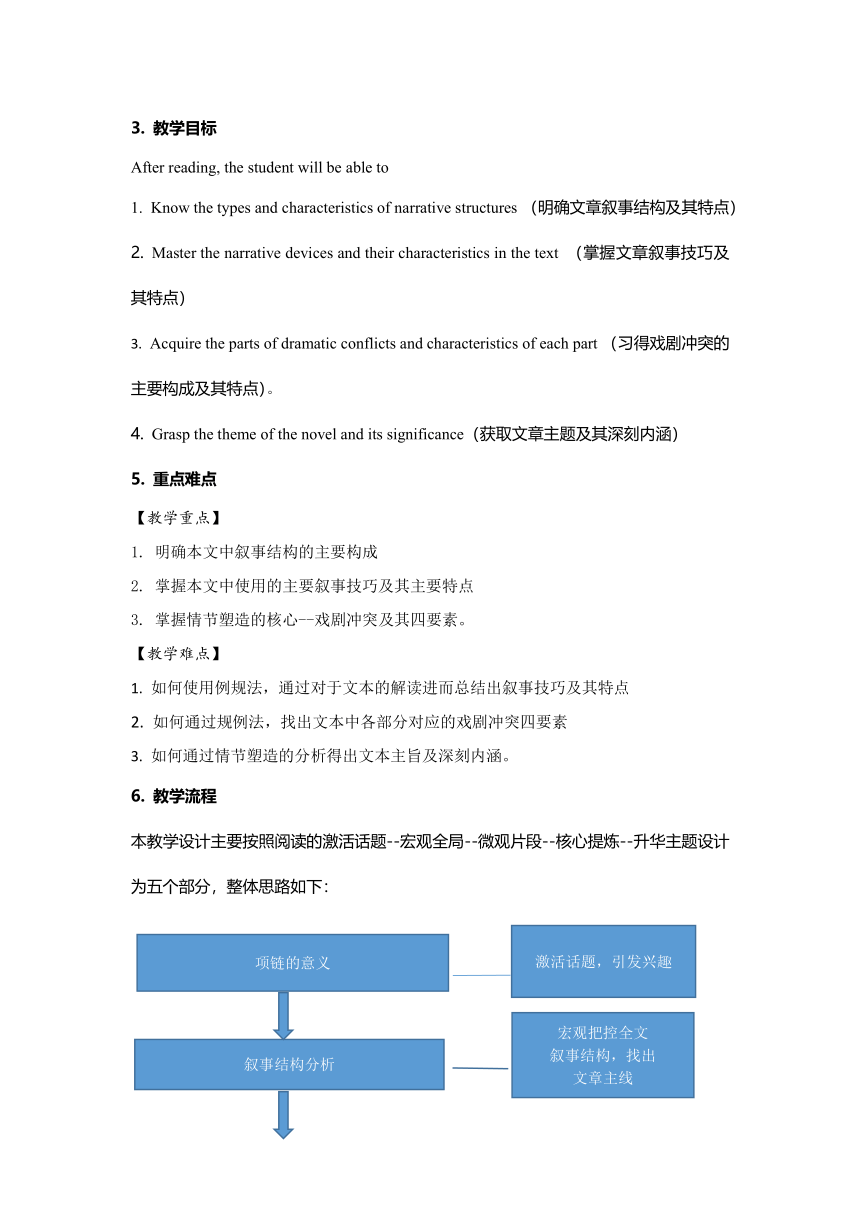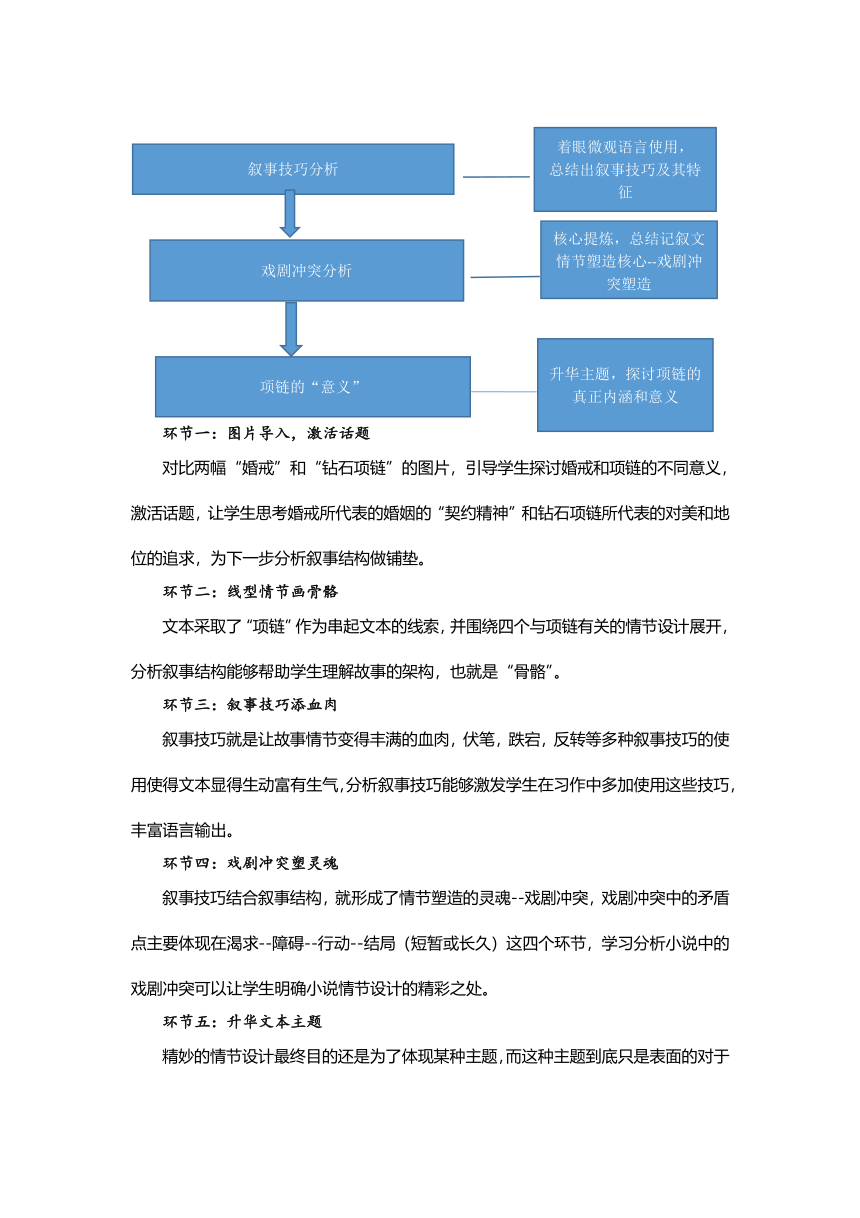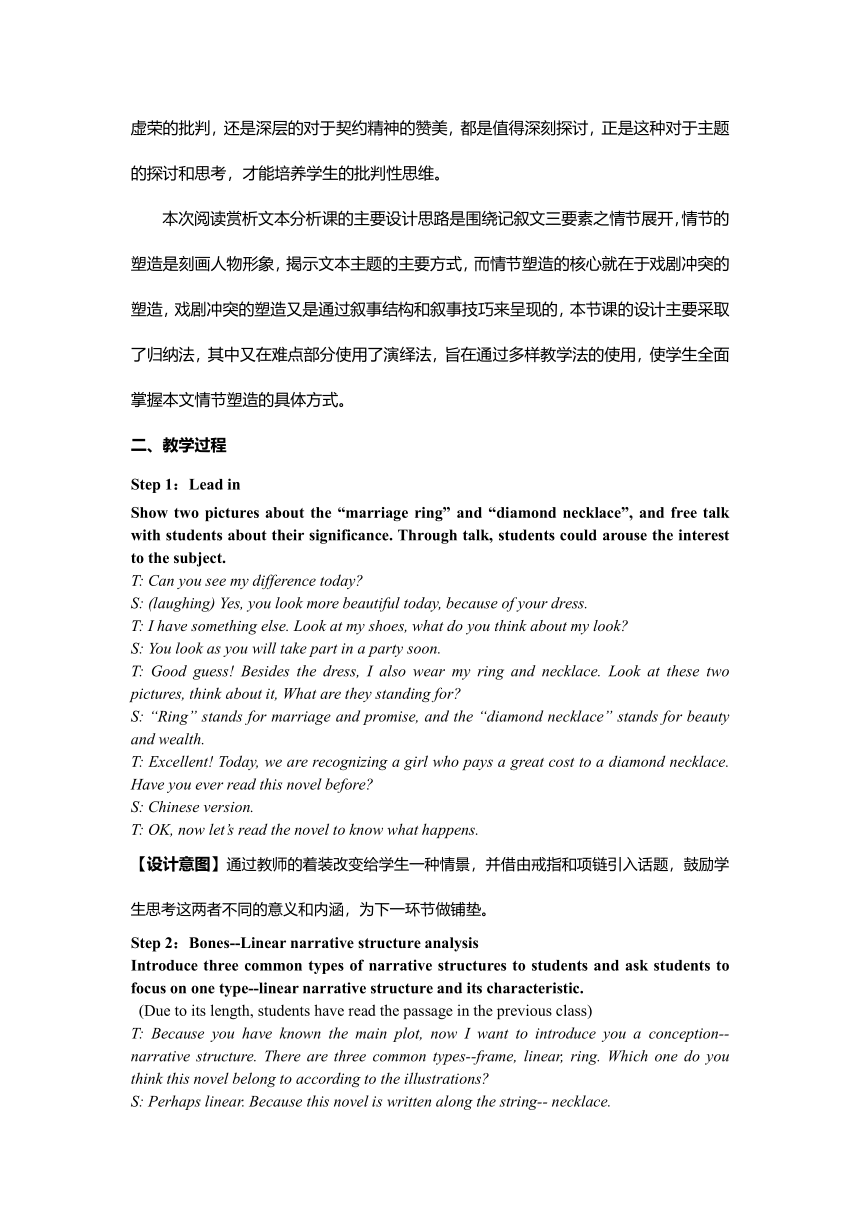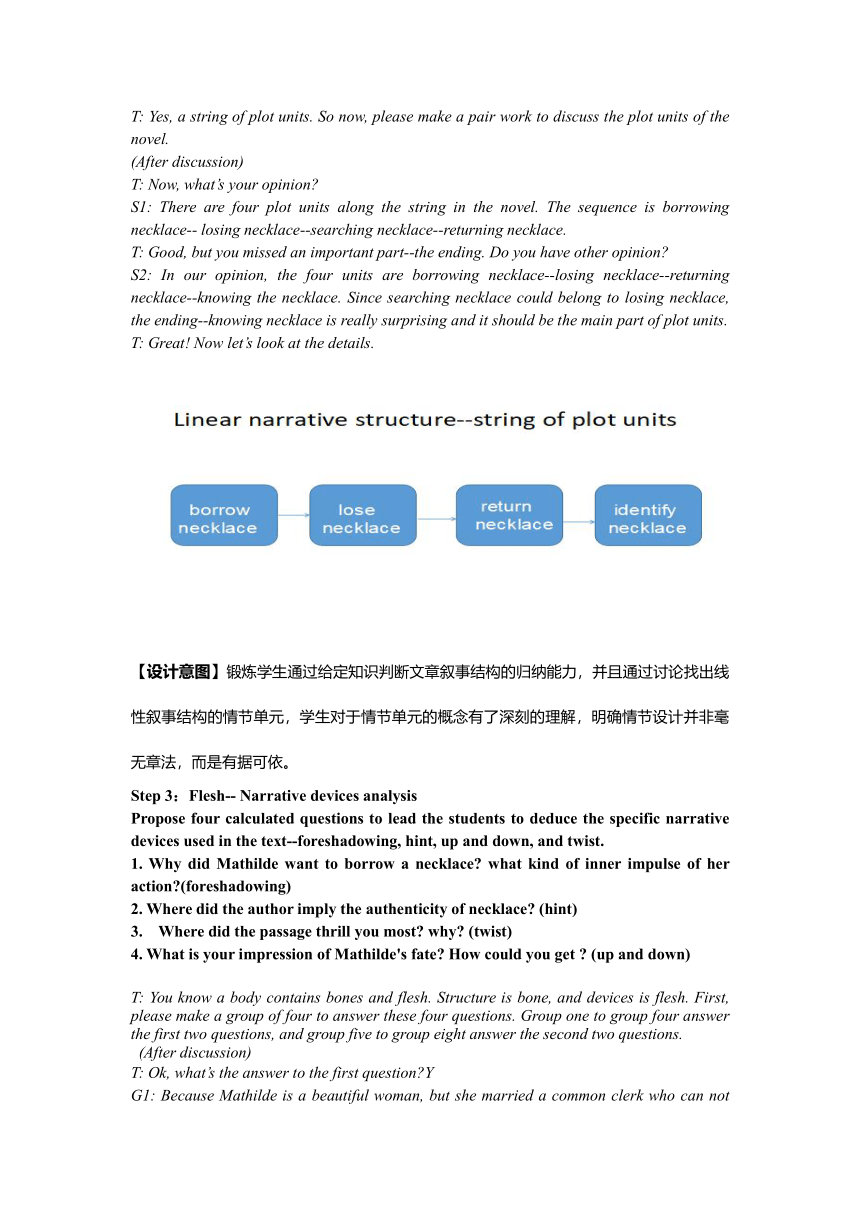牛津上海版高中三年级第一册英语 - Unit 5 A tale with a twist
文档属性
| 名称 | 牛津上海版高中三年级第一册英语 - Unit 5 A tale with a twist |  | |
| 格式 | zip | ||
| 文件大小 | 108.8KB | ||
| 资源类型 | 教案 | ||
| 版本资源 | 牛津上海版(试用本) | ||
| 科目 | 英语 | ||
| 更新时间 | 2020-03-20 22:47:16 | ||
图片预览





文档简介
The Constitution of Plot in Narration
----Necklace 教学设计
教学分析
文本分析
Necklace是法国作家莫泊桑最著名的一部短篇小说,故事讲述了美丽的公务员之妻玛蒂尔德为参加一次晚会,向朋友借了一串钻石项链来炫耀自己的美丽。不料,项链在回家途中不慎丢失。她只得借钱买了新项链还给朋友。为了偿还债务,她节衣缩食,为别人打短工,整整劳苦十年,最后却得知所借的项链原是一串假钻石项链。 《项链》采用了以物写人的方法,将项链作为一条主线推进情节发展,使故事情节更为有序而集中,这种结构能够直观的表现事物发展的过程,使读者轻松自然的了解到整个故事的发展脉络。作者在构思布局上也不落俗套,其中“十年后相遇揭示项链真假”的艺术巧思极具匠心,小说之所以不急于把谜底点破,而是放到十年之后,就是要让当事人和读者同时为之一惊,增强出人意料的喜剧效果,从而使作品结束时产生强烈的震撼人们心灵的悲情艺术效果。文章在结局时情节的反转给读者留下无限遐想空间,在主题呈现上,除了玛蒂尔德前期因为虚荣所付出的代价,在后期塑造上却又让读者看到了另一个尊重契约,有责任感的玛蒂尔德。学生们不仅能学到情节塑造的技巧及方式,还能在分析情节的同时深刻领会文本主题,拥有自己的独特见解。由于课堂时间有限,笔者在教学材料的选取上,进行了主要情节的保留并且根据教学设计将文本整合成三个部分。教学过程中,教师引领学生通过对叙事结构,叙事技巧的分析最终得出作者对于戏剧冲突的塑造方式并进一步升华主题。
学生分析
此次授课对象是G省某重点中学国际英才班的高二学生,经过两年专业系统的英语学习及阅读策略的培养,他们的语言功底、阅读技巧都远超同龄学生,进而需要提升的就是他们对于语言的鉴赏能力以及透过语言使用挖掘主题的能力。由于语言及文化的差异,英语原著类记叙文是他们最感兴趣却也最难读懂作者深意的一类文本,因此教师可以通过各种阅读实践活动的设计来引导学生透过文本表面理解作者的深刻意图,进而提升他们的思维能力。
教学目标
After reading, the student will be able to
Know the types and characteristics of narrative structures (明确文章叙事结构及其特点)
Master the narrative devices and their characteristics in the text (掌握文章叙事技巧及其特点)
Acquire the parts of dramatic conflicts and characteristics of each part (习得戏剧冲突的主要构成及其特点)。
Grasp the theme of the novel and its significance(获取文章主题及其深刻内涵)
重点难点
【教学重点】
明确本文中叙事结构的主要构成
掌握本文中使用的主要叙事技巧及其主要特点
掌握情节塑造的核心--戏剧冲突及其四要素。
【教学难点】
如何使用例规法,通过对于文本的解读进而总结出叙事技巧及其特点
如何通过规例法,找出文本中各部分对应的戏剧冲突四要素
如何通过情节塑造的分析得出文本主旨及深刻内涵。
教学流程
本教学设计主要按照阅读的激活话题--宏观全局--微观片段--核心提炼--升华主题设计为五个部分,整体思路如下:
环节一:图片导入,激活话题
对比两幅“婚戒”和“钻石项链”的图片,引导学生探讨婚戒和项链的不同意义, 激活话题,让学生思考婚戒所代表的婚姻的“契约精神”和钻石项链所代表的对美和地位的追求,为下一步分析叙事结构做铺垫。
环节二:线型情节画骨骼
文本采取了“项链”作为串起文本的线索,并围绕四个与项链有关的情节设计展开,分析叙事结构能够帮助学生理解故事的架构,也就是“骨骼”。
环节三:叙事技巧添血肉
叙事技巧就是让故事情节变得丰满的血肉,伏笔,跌宕,反转等多种叙事技巧的使用使得文本显得生动富有生气,分析叙事技巧能够激发学生在习作中多加使用这些技巧,丰富语言输出。
环节四:戏剧冲突塑灵魂
叙事技巧结合叙事结构,就形成了情节塑造的灵魂--戏剧冲突,戏剧冲突中的矛盾点主要体现在渴求--障碍--行动--结局(短暂或长久)这四个环节,学习分析小说中的戏剧冲突可以让学生明确小说情节设计的精彩之处。
环节五:升华文本主题
精妙的情节设计最终目的还是为了体现某种主题,而这种主题到底只是表面的对于虚荣的批判,还是深层的对于契约精神的赞美,都是值得深刻探讨,正是这种对于主题的探讨和思考,才能培养学生的批判性思维。
本次阅读赏析文本分析课的主要设计思路是围绕记叙文三要素之情节展开,情节的塑造是刻画人物形象,揭示文本主题的主要方式,而情节塑造的核心就在于戏剧冲突的塑造,戏剧冲突的塑造又是通过叙事结构和叙事技巧来呈现的,本节课的设计主要采取了归纳法,其中又在难点部分使用了演绎法,旨在通过多样教学法的使用,使学生全面掌握本文情节塑造的具体方式。
教学过程
Step 1:Lead in
Show two pictures about the “marriage ring” and “diamond necklace”, and free talk with students about their significance. Through talk, students could arouse the interest to the subject.
T: Can you see my difference today?
S: (laughing) Yes, you look more beautiful today, because of your dress.
T: I have something else. Look at my shoes, what do you think about my look?
S: You look as you will take part in a party soon.
T: Good guess! Besides the dress, I also wear my ring and necklace. Look at these two pictures, think about it, What are they standing for?
S: “Ring” stands for marriage and promise, and the “diamond necklace” stands for beauty and wealth.
T: Excellent! Today, we are recognizing a girl who pays a great cost to a diamond necklace. Have you ever read this novel before?
S: Chinese version.
T: OK, now let’s read the novel to know what happens.
【设计意图】通过教师的着装改变给学生一种情景,并借由戒指和项链引入话题,鼓励学生思考这两者不同的意义和内涵,为下一环节做铺垫。
Step 2:Bones--Linear narrative structure analysis
Introduce three common types of narrative structures to students and ask students to focus on one type--linear narrative structure and its characteristic.
(Due to its length, students have read the passage in the previous class)
T: Because you have known the main plot, now I want to introduce you a conception-- narrative structure. There are three common types--frame, linear, ring. Which one do you think this novel belong to according to the illustrations?
S: Perhaps linear. Because this novel is written along the string-- necklace.
T: Yes, a string of plot units. So now, please make a pair work to discuss the plot units of the novel.
(After discussion)
T: Now, what’s your opinion?
S1: There are four plot units along the string in the novel. The sequence is borrowing necklace-- losing necklace--searching necklace--returning necklace.
T: Good, but you missed an important part--the ending. Do you have other opinion?
S2: In our opinion, the four units are borrowing necklace--losing necklace--returning necklace--knowing the necklace. Since searching necklace could belong to losing necklace, the ending--knowing necklace is really surprising and it should be the main part of plot units.
T: Great! Now let’s look at the details.
【设计意图】锻炼学生通过给定知识判断文章叙事结构的归纳能力,并且通过讨论找出线性叙事结构的情节单元,学生对于情节单元的概念有了深刻的理解,明确情节设计并非毫无章法,而是有据可依。
Step 3:Flesh-- Narrative devices analysis
Propose four calculated questions to lead the students to deduce the specific narrative devices used in the text--foreshadowing, hint, up and down, and twist.
1. Why did Mathilde want to borrow a necklace? what kind of inner impulse of her action?(foreshadowing)
2. Where did the author imply the authenticity of necklace? (hint)
3. Where did the passage thrill you most? why? (twist)
4. What is your impression of Mathilde's fate? How could you get ? (up and down)
T: You know a body contains bones and flesh. Structure is bone, and devices is flesh. First, please make a group of four to answer these four questions. Group one to group four answer the first two questions, and group five to group eight answer the second two questions.
(After discussion)
T: Ok, what’s the answer to the first question?Y
G1: Because Mathilde is a beautiful woman, but she married a common clerk who can not give her what she wants. The text describes a lot about her mood, her anger and her beauty.
T: Yes, this device is called“foreshadowing”.what about the second one?
G2: I have found two points that imply the necklace is fake. One is when her friend lent the necklace to her. I will never lend my friend a diamond necklace without a second thought. Second point is when Mathilde returned the necklace, and her friend did not even check it. I think it is really strange.
T: Good. This device is called “hint”, and the third one?
G3: The ending surprised me most, because I can not imagine the necklace is fake. What a shock to Mathilde! I thought the story will have a happy ending, but the author surprised me!
T: (laughing) This is called “twist” and the fourth one?
G4: Mathilde is really a sad figure. Her fate is full of sorrows. First second, she was sunk into the happiness of showing her beauty, next second, her borrowed necklace was lost. She tried her best to repay the money, but next moment, she knew the necklace was fake. It is really torturing.
T: This is called “up and down”. There are other narrative devices used in the text, but today our focus is on these four. Good job!
【设计意图】通过对于具体细节叙事技巧的分析,来归纳出四种叙事技巧及各自的特色,学生经过这种分析训练,能够激发学生的创作思维,在自己的习作中运用类似的叙事技巧来设计故事情节。
Step 4 Soul--Dramatic conflicts analysis
Get the Ss to analyze the dramatic conflicts in the passage and its main elements-- desire, obstacle, acts and denouement.
T: The body and the soul can not be separated, and the body is the conveyor of the soul. Narrative structure and narrative devices constitute the soul of plot constitution-- dramatic conflicts. And a dramatic conflict has its desire, obstacle, acts and denouement. Now make a group of four to discuss the dramatic conflicts in each part of passage and fill the chart below.
(After filling the chart)
T: Well done. Now let’s look at the words from the text “What would have happened if she had never lost those jewels. Who knows? Who knows? How strange life is, how fickle! How little is needed to ruin or to save!”, what ruined her life? And what saved her life?
S: Vanity ruined her life. Her diligence saved her.
T: Good idea. Any other ideas?
S: In my opinion, her husband’s loyalty also saved her. She did something wrong, and her husband kept supporting her and working hard to pay back the debt.
T: Excellent, anything else?
S: Her faithfulness saved her. She was faithful to her friend, because she did not give up or escape when she lost the “expensive” necklace.
T: Unbelievable! You have so many ideas that I can not think out. Actually, the loyalty to marriage and friendship or the spirit “YOU HAVE TO PAY FOR YOUR COST” is called “social contract”,which is an important spirit in western culture, like “filial piety” in Chinese culture. Now look at the curve of Mathilde’s fate and think about other questions.
【设计意图】戏剧冲突是构成情节的核心。通过对于戏剧冲突的分析进而得出一幅关于命运的曲线图,借此奠定升华主题的基础,“契约精神”是西方文明思想中一个重要元素,因此在《项链》这部作品中,并没有因难抛妻的丈夫,也没有因难背信的朋友,通过对于救赎和毁灭的探讨来进行下一步的主题升华。
Step 5 Appreciating the theme conveyed in the plot
Propose questions to acquire the theme of the text. Ask students to make a group to choose a question to answer.
What ruined Mathilde?And what saved Mathilde?
What did the author actually hope to reveal through plot constitution?
What actions would happen after the original ending?
(After discussion)
T: Now, let us check your answers. I am interested in the third question. Who could share his/ her imagination?
S: Mathilde was at first a little shocked, but she quickly took it easy. After ten years hard work, she became a lot. She was not that young woman who loved clothes and jewel most. She remembered her husband had bought her a new dress with the money he intended to buy a gun. This time, Mathilde wanted to give her husband some care and love. They bought the new house with the extra money, but this time Mathilde did not care it any more. They lived happily forever.
T: So you set a happy ending for Mathilde?
S: Yes, she deserved such a happy ending. Why is the author so cruel to a young beautiful girl?
T: I am not sure the real motive, but I guess he wants to be an objective observer who just show a choice question to the reader. Now let’s make a short summary.
【设计意图】情节塑造最终目的是为了呈现作者想要表达的主题及真实意图,《项链》作为世界经典名著,在传统教学中更加重视对于玛蒂尔德虚荣的批判,而本节课着重于挖掘一些更正面的对于“契约精神”的歌颂,学生们通过多角度的分析可以形成自己对于一些文章的深刻认识。开放式结局留下一个反转之后的悬念,而据此设计的开放式问题有助于锻炼学生的创新思维和批判性思维。
Step 6 Homework
1. Try to analyze the trait of each character in the passage.
2. Contemplate the relationship among three elements in narration--character, plot and theme.
【设计意图】巩固课堂所学,教学设计中只涉及了情节和主题,人物的刻画也是叙事成功的条件,鼓励学生在课后继续进行人物刻画的分析,并且深层思考人物、情节与主题之间的关系,确保掌握并深层理解记叙类文本中的三元素。
教学反思
情节分析解读文本之“妙”
在读一本名著时,看到跌宕起伏的情节设计,总会感叹作者写的很妙,但是妙在哪儿却又总是说不清道不明。小时候在语文课本上第一次接触《项链》这部小说时,这部作品结尾之处的反转情节就让我印象深刻。牛津版英语教材中为了削弱词汇及课堂教学等难度,对于英语译本进行了一定程度的改编和删减,保留了其中的重要情节来突出“反转”。我任教的学生都是有很强英语基础的学生,因此大胆的对原文进行了挑选,想要进行更深层次的探索式教学。
在教学设计的过程中,经过不断推敲和学习,终于确定了叙事结构-叙事技巧-戏剧冲突-升华主题的一条设计主线。这条设计主线是依照由表及里,由浅到深的层次进行推进的。项链作为这篇文章的主线串起了整篇文章的情节,也构成了一种线型叙事结构,而在每个情节单元,作者又使用了不同的叙事技巧来凸显情节的曲折变换。这些叙事技巧的挖掘则会引导学生在未来的语言输出方面增强语言的丰富性。设计最终的落脚点是戏剧及小说类的核心--戏剧冲突。戏剧冲突的塑造是整个小说中矛盾的凸显点,《项链》这部小说就是通过真假项链的冲突来突出整篇小说的灵魂。通过对于教学片段的设计,带领学生将之前阅读文本的愉悦感受变成有理有据的语言分析,激发学生领悟语言之“妙”,是情节塑造分析的重要目标。
情节分析突出主题之“深”
每一部经典名著,无论情节的塑造多么耗费作者的笔墨和心血,但最终目的还是为了突出作者的意图及主题。本节课的设计在解读主题方面,突出了对于西方文化中“契约精神”的探讨,而这种解读在很大程度上受到毕飞宇先生的《小说课》这部作品的启发。看《项链》英文译作时,有一句原文让我百思不得其解,“What would have happened if she had never lost those jewels. Who knows? Who knows? How strange life is, how fickle! How little is needed to ruin or to save! “. ”毁灭“和”救赎“本来是一组反义词,而我之前的理解是女主角放弃虚荣,热爱劳动等美好品质救赎了她,可是十年的辛劳并不算”few”,为什么作者会说只需要极少的东西就能毁灭或者救赎一个人呢?如果是虚荣毁了玛蒂尔德,那么是什么救赎了她呢?毕飞宇先生在品评《项链》这部作品中提到了西方文化中很重要的一个元素--契约精神,这种解读让我茅塞顿开。玛蒂尔德丢失了钻石项链的时候,她的丈夫路瓦塞遵守了”婚姻“契约,陪她一起借钱,做苦工还债,玛蒂尔德遵守了”忠诚“契约--借钱要还,丢物要赔,她可以放弃自己以往的安逸生活和虚荣,去践行”契约精神“,这种深刻的主题解读对于培养学生的批判性思维大有裨益。在这一部分的教学设计中,不仅加入了主题的探讨和解读,更是鼓励学生设计一个续篇来将这个故事续写下去,学生们在获得了足够的语言输入后,可以将自己的态度和价值观融入在语言输出中,对于培养学生的创新思维也很有帮助。
(附:板书设计)
The Constitution of Plot in Narration
----Necklace 教学设计
教学分析
文本分析
Necklace是法国作家莫泊桑最著名的一部短篇小说,故事讲述了美丽的公务员之妻玛蒂尔德为参加一次晚会,向朋友借了一串钻石项链来炫耀自己的美丽。不料,项链在回家途中不慎丢失。她只得借钱买了新项链还给朋友。为了偿还债务,她节衣缩食,为别人打短工,整整劳苦十年,最后却得知所借的项链原是一串假钻石项链。 《项链》采用了以物写人的方法,将项链作为一条主线推进情节发展,使故事情节更为有序而集中,这种结构能够直观的表现事物发展的过程,使读者轻松自然的了解到整个故事的发展脉络。作者在构思布局上也不落俗套,其中“十年后相遇揭示项链真假”的艺术巧思极具匠心,小说之所以不急于把谜底点破,而是放到十年之后,就是要让当事人和读者同时为之一惊,增强出人意料的喜剧效果,从而使作品结束时产生强烈的震撼人们心灵的悲情艺术效果。文章在结局时情节的反转给读者留下无限遐想空间,在主题呈现上,除了玛蒂尔德前期因为虚荣所付出的代价,在后期塑造上却又让读者看到了另一个尊重契约,有责任感的玛蒂尔德。学生们不仅能学到情节塑造的技巧及方式,还能在分析情节的同时深刻领会文本主题,拥有自己的独特见解。由于课堂时间有限,笔者在教学材料的选取上,进行了主要情节的保留并且根据教学设计将文本整合成三个部分。教学过程中,教师引领学生通过对叙事结构,叙事技巧的分析最终得出作者对于戏剧冲突的塑造方式并进一步升华主题。
学生分析
此次授课对象是G省某重点中学国际英才班的高二学生,经过两年专业系统的英语学习及阅读策略的培养,他们的语言功底、阅读技巧都远超同龄学生,进而需要提升的就是他们对于语言的鉴赏能力以及透过语言使用挖掘主题的能力。由于语言及文化的差异,英语原著类记叙文是他们最感兴趣却也最难读懂作者深意的一类文本,因此教师可以通过各种阅读实践活动的设计来引导学生透过文本表面理解作者的深刻意图,进而提升他们的思维能力。
教学目标
After reading, the student will be able to
Know the types and characteristics of narrative structures (明确文章叙事结构及其特点)
Master the narrative devices and their characteristics in the text (掌握文章叙事技巧及其特点)
Acquire the parts of dramatic conflicts and characteristics of each part (习得戏剧冲突的主要构成及其特点)。
Grasp the theme of the novel and its significance(获取文章主题及其深刻内涵)
重点难点
【教学重点】
明确本文中叙事结构的主要构成
掌握本文中使用的主要叙事技巧及其主要特点
掌握情节塑造的核心--戏剧冲突及其四要素。
【教学难点】
如何使用例规法,通过对于文本的解读进而总结出叙事技巧及其特点
如何通过规例法,找出文本中各部分对应的戏剧冲突四要素
如何通过情节塑造的分析得出文本主旨及深刻内涵。
教学流程
本教学设计主要按照阅读的激活话题--宏观全局--微观片段--核心提炼--升华主题设计为五个部分,整体思路如下:
环节一:图片导入,激活话题
对比两幅“婚戒”和“钻石项链”的图片,引导学生探讨婚戒和项链的不同意义, 激活话题,让学生思考婚戒所代表的婚姻的“契约精神”和钻石项链所代表的对美和地位的追求,为下一步分析叙事结构做铺垫。
环节二:线型情节画骨骼
文本采取了“项链”作为串起文本的线索,并围绕四个与项链有关的情节设计展开,分析叙事结构能够帮助学生理解故事的架构,也就是“骨骼”。
环节三:叙事技巧添血肉
叙事技巧就是让故事情节变得丰满的血肉,伏笔,跌宕,反转等多种叙事技巧的使用使得文本显得生动富有生气,分析叙事技巧能够激发学生在习作中多加使用这些技巧,丰富语言输出。
环节四:戏剧冲突塑灵魂
叙事技巧结合叙事结构,就形成了情节塑造的灵魂--戏剧冲突,戏剧冲突中的矛盾点主要体现在渴求--障碍--行动--结局(短暂或长久)这四个环节,学习分析小说中的戏剧冲突可以让学生明确小说情节设计的精彩之处。
环节五:升华文本主题
精妙的情节设计最终目的还是为了体现某种主题,而这种主题到底只是表面的对于虚荣的批判,还是深层的对于契约精神的赞美,都是值得深刻探讨,正是这种对于主题的探讨和思考,才能培养学生的批判性思维。
本次阅读赏析文本分析课的主要设计思路是围绕记叙文三要素之情节展开,情节的塑造是刻画人物形象,揭示文本主题的主要方式,而情节塑造的核心就在于戏剧冲突的塑造,戏剧冲突的塑造又是通过叙事结构和叙事技巧来呈现的,本节课的设计主要采取了归纳法,其中又在难点部分使用了演绎法,旨在通过多样教学法的使用,使学生全面掌握本文情节塑造的具体方式。
教学过程
Step 1:Lead in
Show two pictures about the “marriage ring” and “diamond necklace”, and free talk with students about their significance. Through talk, students could arouse the interest to the subject.
T: Can you see my difference today?
S: (laughing) Yes, you look more beautiful today, because of your dress.
T: I have something else. Look at my shoes, what do you think about my look?
S: You look as you will take part in a party soon.
T: Good guess! Besides the dress, I also wear my ring and necklace. Look at these two pictures, think about it, What are they standing for?
S: “Ring” stands for marriage and promise, and the “diamond necklace” stands for beauty and wealth.
T: Excellent! Today, we are recognizing a girl who pays a great cost to a diamond necklace. Have you ever read this novel before?
S: Chinese version.
T: OK, now let’s read the novel to know what happens.
【设计意图】通过教师的着装改变给学生一种情景,并借由戒指和项链引入话题,鼓励学生思考这两者不同的意义和内涵,为下一环节做铺垫。
Step 2:Bones--Linear narrative structure analysis
Introduce three common types of narrative structures to students and ask students to focus on one type--linear narrative structure and its characteristic.
(Due to its length, students have read the passage in the previous class)
T: Because you have known the main plot, now I want to introduce you a conception-- narrative structure. There are three common types--frame, linear, ring. Which one do you think this novel belong to according to the illustrations?
S: Perhaps linear. Because this novel is written along the string-- necklace.
T: Yes, a string of plot units. So now, please make a pair work to discuss the plot units of the novel.
(After discussion)
T: Now, what’s your opinion?
S1: There are four plot units along the string in the novel. The sequence is borrowing necklace-- losing necklace--searching necklace--returning necklace.
T: Good, but you missed an important part--the ending. Do you have other opinion?
S2: In our opinion, the four units are borrowing necklace--losing necklace--returning necklace--knowing the necklace. Since searching necklace could belong to losing necklace, the ending--knowing necklace is really surprising and it should be the main part of plot units.
T: Great! Now let’s look at the details.
【设计意图】锻炼学生通过给定知识判断文章叙事结构的归纳能力,并且通过讨论找出线性叙事结构的情节单元,学生对于情节单元的概念有了深刻的理解,明确情节设计并非毫无章法,而是有据可依。
Step 3:Flesh-- Narrative devices analysis
Propose four calculated questions to lead the students to deduce the specific narrative devices used in the text--foreshadowing, hint, up and down, and twist.
1. Why did Mathilde want to borrow a necklace? what kind of inner impulse of her action?(foreshadowing)
2. Where did the author imply the authenticity of necklace? (hint)
3. Where did the passage thrill you most? why? (twist)
4. What is your impression of Mathilde's fate? How could you get ? (up and down)
T: You know a body contains bones and flesh. Structure is bone, and devices is flesh. First, please make a group of four to answer these four questions. Group one to group four answer the first two questions, and group five to group eight answer the second two questions.
(After discussion)
T: Ok, what’s the answer to the first question?Y
G1: Because Mathilde is a beautiful woman, but she married a common clerk who can not give her what she wants. The text describes a lot about her mood, her anger and her beauty.
T: Yes, this device is called“foreshadowing”.what about the second one?
G2: I have found two points that imply the necklace is fake. One is when her friend lent the necklace to her. I will never lend my friend a diamond necklace without a second thought. Second point is when Mathilde returned the necklace, and her friend did not even check it. I think it is really strange.
T: Good. This device is called “hint”, and the third one?
G3: The ending surprised me most, because I can not imagine the necklace is fake. What a shock to Mathilde! I thought the story will have a happy ending, but the author surprised me!
T: (laughing) This is called “twist” and the fourth one?
G4: Mathilde is really a sad figure. Her fate is full of sorrows. First second, she was sunk into the happiness of showing her beauty, next second, her borrowed necklace was lost. She tried her best to repay the money, but next moment, she knew the necklace was fake. It is really torturing.
T: This is called “up and down”. There are other narrative devices used in the text, but today our focus is on these four. Good job!
【设计意图】通过对于具体细节叙事技巧的分析,来归纳出四种叙事技巧及各自的特色,学生经过这种分析训练,能够激发学生的创作思维,在自己的习作中运用类似的叙事技巧来设计故事情节。
Step 4 Soul--Dramatic conflicts analysis
Get the Ss to analyze the dramatic conflicts in the passage and its main elements-- desire, obstacle, acts and denouement.
T: The body and the soul can not be separated, and the body is the conveyor of the soul. Narrative structure and narrative devices constitute the soul of plot constitution-- dramatic conflicts. And a dramatic conflict has its desire, obstacle, acts and denouement. Now make a group of four to discuss the dramatic conflicts in each part of passage and fill the chart below.
(After filling the chart)
T: Well done. Now let’s look at the words from the text “What would have happened if she had never lost those jewels. Who knows? Who knows? How strange life is, how fickle! How little is needed to ruin or to save!”, what ruined her life? And what saved her life?
S: Vanity ruined her life. Her diligence saved her.
T: Good idea. Any other ideas?
S: In my opinion, her husband’s loyalty also saved her. She did something wrong, and her husband kept supporting her and working hard to pay back the debt.
T: Excellent, anything else?
S: Her faithfulness saved her. She was faithful to her friend, because she did not give up or escape when she lost the “expensive” necklace.
T: Unbelievable! You have so many ideas that I can not think out. Actually, the loyalty to marriage and friendship or the spirit “YOU HAVE TO PAY FOR YOUR COST” is called “social contract”,which is an important spirit in western culture, like “filial piety” in Chinese culture. Now look at the curve of Mathilde’s fate and think about other questions.
【设计意图】戏剧冲突是构成情节的核心。通过对于戏剧冲突的分析进而得出一幅关于命运的曲线图,借此奠定升华主题的基础,“契约精神”是西方文明思想中一个重要元素,因此在《项链》这部作品中,并没有因难抛妻的丈夫,也没有因难背信的朋友,通过对于救赎和毁灭的探讨来进行下一步的主题升华。
Step 5 Appreciating the theme conveyed in the plot
Propose questions to acquire the theme of the text. Ask students to make a group to choose a question to answer.
What ruined Mathilde?And what saved Mathilde?
What did the author actually hope to reveal through plot constitution?
What actions would happen after the original ending?
(After discussion)
T: Now, let us check your answers. I am interested in the third question. Who could share his/ her imagination?
S: Mathilde was at first a little shocked, but she quickly took it easy. After ten years hard work, she became a lot. She was not that young woman who loved clothes and jewel most. She remembered her husband had bought her a new dress with the money he intended to buy a gun. This time, Mathilde wanted to give her husband some care and love. They bought the new house with the extra money, but this time Mathilde did not care it any more. They lived happily forever.
T: So you set a happy ending for Mathilde?
S: Yes, she deserved such a happy ending. Why is the author so cruel to a young beautiful girl?
T: I am not sure the real motive, but I guess he wants to be an objective observer who just show a choice question to the reader. Now let’s make a short summary.
【设计意图】情节塑造最终目的是为了呈现作者想要表达的主题及真实意图,《项链》作为世界经典名著,在传统教学中更加重视对于玛蒂尔德虚荣的批判,而本节课着重于挖掘一些更正面的对于“契约精神”的歌颂,学生们通过多角度的分析可以形成自己对于一些文章的深刻认识。开放式结局留下一个反转之后的悬念,而据此设计的开放式问题有助于锻炼学生的创新思维和批判性思维。
Step 6 Homework
1. Try to analyze the trait of each character in the passage.
2. Contemplate the relationship among three elements in narration--character, plot and theme.
【设计意图】巩固课堂所学,教学设计中只涉及了情节和主题,人物的刻画也是叙事成功的条件,鼓励学生在课后继续进行人物刻画的分析,并且深层思考人物、情节与主题之间的关系,确保掌握并深层理解记叙类文本中的三元素。
教学反思
情节分析解读文本之“妙”
在读一本名著时,看到跌宕起伏的情节设计,总会感叹作者写的很妙,但是妙在哪儿却又总是说不清道不明。小时候在语文课本上第一次接触《项链》这部小说时,这部作品结尾之处的反转情节就让我印象深刻。牛津版英语教材中为了削弱词汇及课堂教学等难度,对于英语译本进行了一定程度的改编和删减,保留了其中的重要情节来突出“反转”。我任教的学生都是有很强英语基础的学生,因此大胆的对原文进行了挑选,想要进行更深层次的探索式教学。
在教学设计的过程中,经过不断推敲和学习,终于确定了叙事结构-叙事技巧-戏剧冲突-升华主题的一条设计主线。这条设计主线是依照由表及里,由浅到深的层次进行推进的。项链作为这篇文章的主线串起了整篇文章的情节,也构成了一种线型叙事结构,而在每个情节单元,作者又使用了不同的叙事技巧来凸显情节的曲折变换。这些叙事技巧的挖掘则会引导学生在未来的语言输出方面增强语言的丰富性。设计最终的落脚点是戏剧及小说类的核心--戏剧冲突。戏剧冲突的塑造是整个小说中矛盾的凸显点,《项链》这部小说就是通过真假项链的冲突来突出整篇小说的灵魂。通过对于教学片段的设计,带领学生将之前阅读文本的愉悦感受变成有理有据的语言分析,激发学生领悟语言之“妙”,是情节塑造分析的重要目标。
情节分析突出主题之“深”
每一部经典名著,无论情节的塑造多么耗费作者的笔墨和心血,但最终目的还是为了突出作者的意图及主题。本节课的设计在解读主题方面,突出了对于西方文化中“契约精神”的探讨,而这种解读在很大程度上受到毕飞宇先生的《小说课》这部作品的启发。看《项链》英文译作时,有一句原文让我百思不得其解,“What would have happened if she had never lost those jewels. Who knows? Who knows? How strange life is, how fickle! How little is needed to ruin or to save! “. ”毁灭“和”救赎“本来是一组反义词,而我之前的理解是女主角放弃虚荣,热爱劳动等美好品质救赎了她,可是十年的辛劳并不算”few”,为什么作者会说只需要极少的东西就能毁灭或者救赎一个人呢?如果是虚荣毁了玛蒂尔德,那么是什么救赎了她呢?毕飞宇先生在品评《项链》这部作品中提到了西方文化中很重要的一个元素--契约精神,这种解读让我茅塞顿开。玛蒂尔德丢失了钻石项链的时候,她的丈夫路瓦塞遵守了”婚姻“契约,陪她一起借钱,做苦工还债,玛蒂尔德遵守了”忠诚“契约--借钱要还,丢物要赔,她可以放弃自己以往的安逸生活和虚荣,去践行”契约精神“,这种深刻的主题解读对于培养学生的批判性思维大有裨益。在这一部分的教学设计中,不仅加入了主题的探讨和解读,更是鼓励学生设计一个续篇来将这个故事续写下去,学生们在获得了足够的语言输入后,可以将自己的态度和价值观融入在语言输出中,对于培养学生的创新思维也很有帮助。
(附:板书设计)
The Constitution of Plot in Narration
